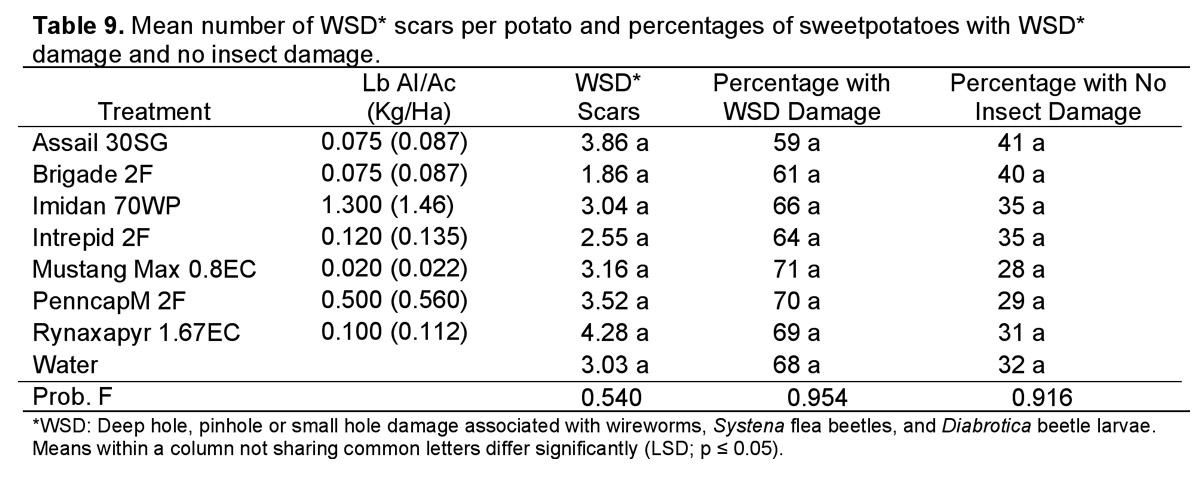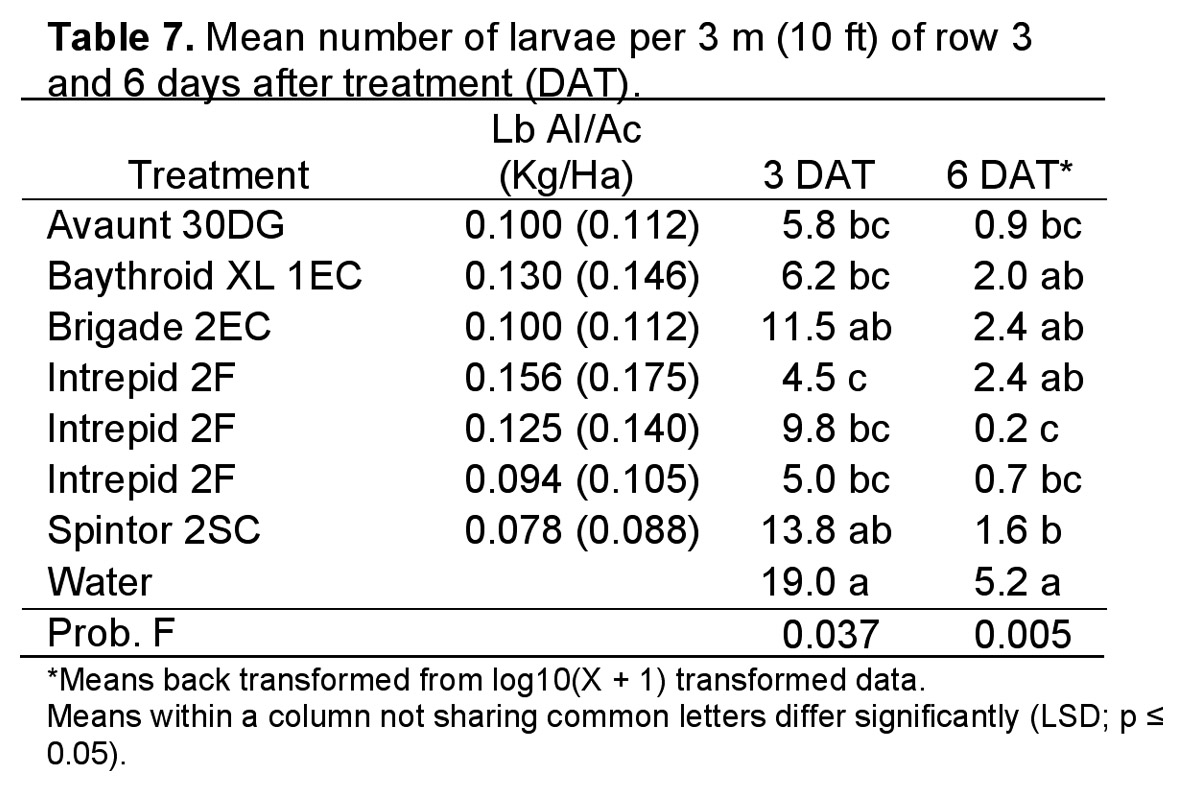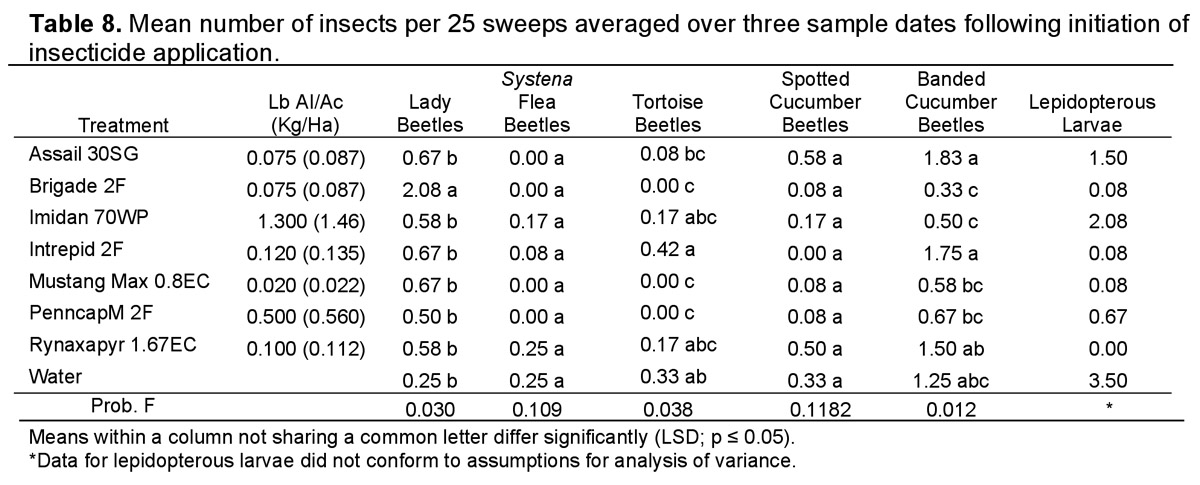Report
Evaluation of Insecticides for Management of Sweetpotato Insect Pests [pdf]
J. T. Reed1, D. Bao1, C. S. Jackson1, and D. Cook2
1Dept. of Entomology and Plant Pathology, Mississippi State University, Box 9775,
Mississippi State, MS 39762.
Phone: (662) 325-2976. jreed@entomology.msstate.edu.
2Delta Research and Extension Center, Stoneville, MS.
Received: 27-V-2009 Accepted: 2-VI-2009
Abstract: Seventeen compounds were applied as preplant or lay-by incorporated treatments and were evaluated in replicated small plot trials for management of soil-borne insects, and foliar insecticides were applied for management of leaf-feeding insects. Although several treatments reduced damage to sweetpotato roots, some soil incorporated treatments resulted in higher insect counts for one or more species or more insect damaged sweetpotatoes than the water treated check plots. All treatments used for dingy cutworm were effective, however pyrethroids were less effective than were other compounts evaluated in the trial. The evaluation for foliage feeding insects resulted in significant differences in lady beetles and tortoise beetles compared to the check plots, but insect damage to sweetpotato roots did not differ between treatments.
Keywords: cutworm, Diabrotica, Systena, insecticide, Ipomoea batatas
Introduction
Small plot trials of preplant incorporated insecticides (PPI) followed by lay-by incorporated (LBI) applications (Trial 1) and lay-by incorporated applications alone (Trial 2) were conducted to evaluate the management of soil-borne sweetpotato pests, primarily insects in the SWD complex (Systena flea beetles, wirewormsand Diabrotica cucumber beetles). Two additional trials were conducted to evaluate the efficacy of insecticides applied to foliage for control of dingy cutworm (Trial 3) and other insects inhabiting sweetpotato foliage (Trial 4). The compounds evaluated in these trials are listed in Table 1.
Methods: General procedures for preplant incorporated and lay-by incorporated insecticide trials
Insecticides were applied broadcast by using a plot spray tractor equipped with a compressed air plot spray system with Greenleaf 8001 air injection flat-fan nozzles spaced at 48 cm (19 inches). The spray pressure was 276 KPA (40 PSI) and the volumetric application rate was 93.6 L/Ha (10 gal/ac). The spray system was rinsed with water and evacuated with compressed air between each plot. The plots within each replicate were re-hipped immediately following spray application to incorporate the insecticide into the soil. Plots that received lay-by applications of insecticide were treated with the same insecticide rates and equipment settings as used for the PPI treatment. Lay-by applications were incorporated by using a rotary hoe. The experimental design was a randomized complete block with four replicates. Sweetpotatoes were harvested by replicate by digging 50 sweetpotatoes from the center two rows of each plot by use of shovels. Potatoes were washed, dried, and evaluated for damage caused by the WSD insect complex by counting pinholes (1 mm or less in diameter), shallow small holes (1–2 mm wide) and deep hole scars (1–4 mm wide but deeper than 3 mm). Damage from sugarcane beetle and white grubs (broad rough gouges) or whitefringed beetle damage (narrow channels) was rated according to the following scale: 0 = none; 1 = 1–5%; 2 = 6–10%; 3 = 11–20%; 4 = 21–50%; 5 ≥ 50 %. Data were analyzed by using GLM procedures with a fixed treatment effect and a random replicate effect. The Cochran C test was used to evaluate uniformity of the data. Means were separated by using Fisher’s LSD test at p = 0.05.
Methods: Trial 1
Trial 1 was conducted at the Plant Science Research Farm at Mississippi State University, Mississippi State, MS (N33°28’36.06”; W88°46’58.52). Plots were four rows wide (0.97-m [38-inch] spacing) and 15.2 m (50 ft) long with 3.6-m (12-ft) non-sprayed buffers at the ends of each plot and with two unsprayed rows between plots. Prior to planting, hipped rows were flattened by using a do-all, treated with insecticides by using a broadcast treatment and re-hipped immediately after insecticide application. Insecticides were applied 5 June 2008. Sweetpotatoes, Beauregard variety, were planted 6 June 2008. Lay-by insecticide treatments were applied 3 July 2008 and incorporated with a rotary hoe. Sweetpotatoes were harvested by replicate the week of 6 October 2008. Insects in the foliage were sampled by taking 25 sweeps on 12.1 m (40 ft) of row with a 48-cm diameter (19-inch) sweep net weekly throughout July and August, and insect numbers were averaged over four sample dates in July.
Methods: Trial 2
The trial was conducted in Chickasaw Co., MS (GPS location: N33° 49’ 41.8”; W89° 1’ 35.6”). Planting date and harvest date were 5 June and 29 September 2008, respectively. No preplant incorporated insecticide was applied, and lay-by incorporated (LBI) insecticides were applied 8 July 2008. Plots were eight rows wide (1-m [40-inch] spacing) by 15.25 m (50 ft) long, and were separated from each other along the rows by 3.6-m (12-ft) planted buffers. Insects in foliage during the season were sampled weekly following treatment by taking 25 sweeps in the center two rows with a standard sweep net. Data were analyzed by using GLM procedures with a fixed treatment effect and a random replicate effect. Means of the percentage of sweetpotatoes damaged by sugarcane beetle and whitefringed beetle required transformation [arcsin(sqrt(x))] to satisfy the assumption of uniformity as verified by the Cochran C test.
Results: Trial 1
Lady beetles in the Brigade 2E and Lorsban 4E PPI + LBI treatments were significantly more abundant than in the water treated plots and no other treatments differed from the water treatment (Table 2). Systena flea beetle numbers were higher in Brigade 2E PPI + LBI and Assail 30SG PPI + LBI treatments than in the water treatment. No treatment reduced flea beetle numbers below that of the water treated check. It may be that some insecticides increase the attractiveness of the crop for flea beetle adults. The percentage of sweetpotatoes damaged by the WSD complex was higher in the Assail 30SG PPI + LBI treatment than in the water treated control (Table 3). Only Brigade 2EC PPI + LBI, Lorsban 4EC PPI + LBI, Platinum 2FS PPI, and Poncho 5FS PPI treatments reduced WSD damage below that of the water treated control (Table 3). The percentage of sweetpotatoes with no insect damage is based on WSD damage plus damage from any other insect, and since most of the damage was from the WSD insect complex, the percentage of sweetpotatoes without damage was nearly the opposite of the WSD damage for each treatment.

Results: Trial 2
Lay-by insecticide application affected only the number of sweetpotato flea beetles (Table 4). Plots treated with Mustang Max insecticide had significantly fewer sweetpotato flea beetles than the water treated check plots. Plots treated with Poncho 5FS resulted in significantly more of these beetles than other treatments except water, Assail 30SG, and Lorsban 4E. The mean number of small hole scars per potato in plots treated with Brigade 2E, Mustang Max 0.8EC, Platinum 2FS, and Regent 4SC was significantly less than that of the water treated check plots (Table 5). The mean number of small hole and deep hole scars in plots treated with Poncho 5FS and Assail 30SG was significantly greater than that of all other treatments except water. Regent 4SC reduced the number of deep hole scars below that of all other treatments, and the number of small hole scars below that of all treatments except Brigade 2E and Platinum 2FS. No treatments reduced pinhole, rough gouge or narrow channel scar numbers below those of the water treated check plots. The only treatments with a percentage of undamaged sweetpotatoes significantly different from that of the water treatment were Poncho 5FS (significantly more damaged roots) and Brigade 2E (significantly fewer damaged roots) (Table 6). Only the Regent 4SC treatment reduced the percentage of roots damaged by the SWD insect complex.
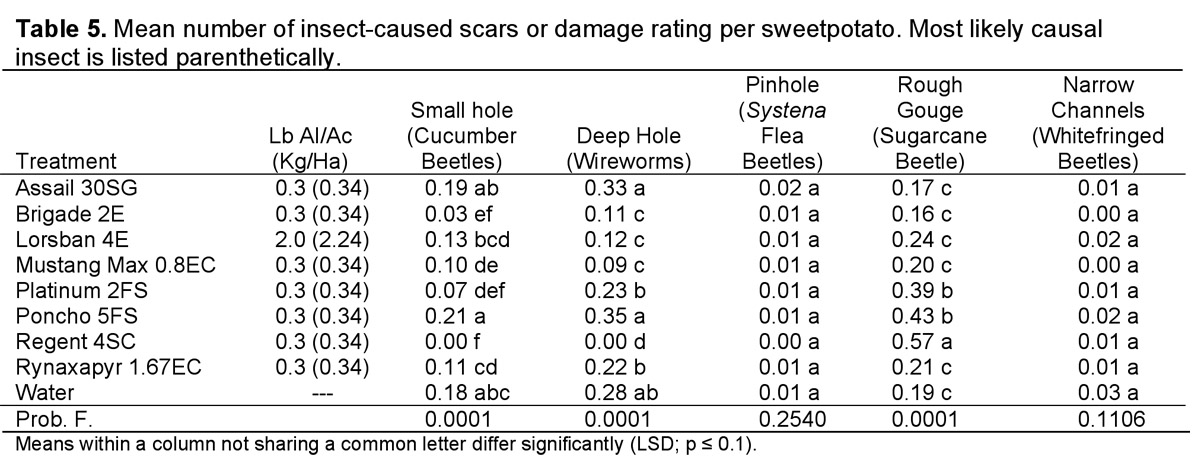
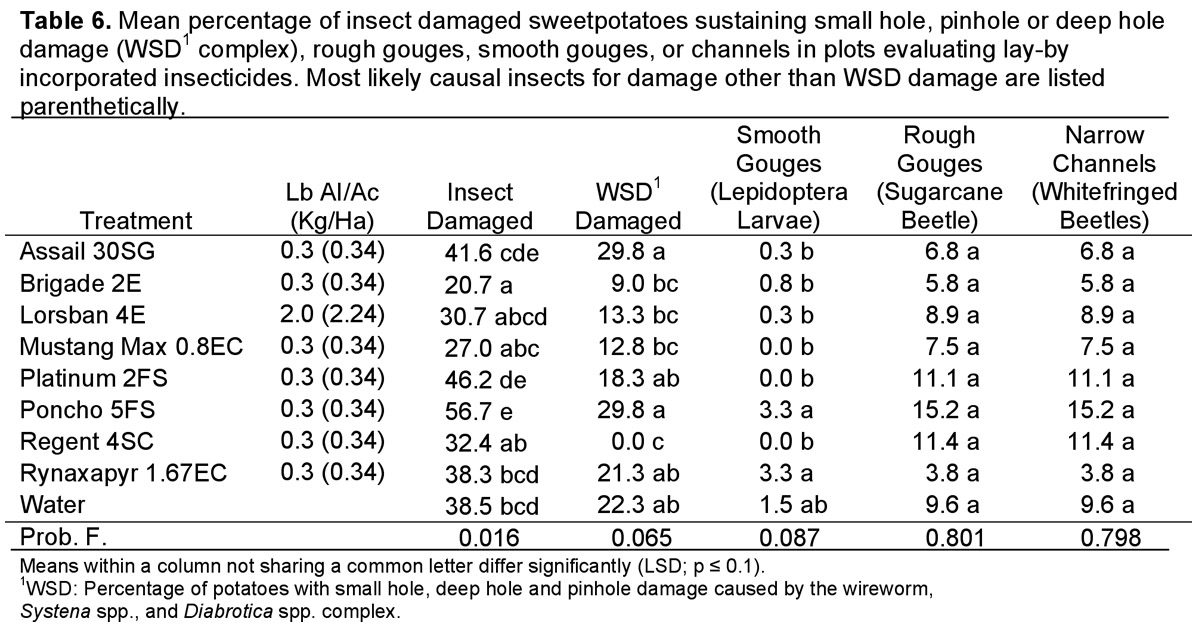
Methods: General procedures for foliar insecticide trials
Sweetpotato plants in the test areas had completely covered the middle areas of the rows when spraying was initiated. Treatments were applied at 276 KPA (40 PSI) and 93.6 L/Ha (10 GPA) by using a spray tractor equipped with a compressed-air plot sprayer with two TX-4 hollow-cone nozzles per row (inner six rows) and one Greenleaf 8001 air injection flat fan nozzle over rows one and eight to minimize drift onto adjacent plots.
Methods: Trial 3 (Dingy Cutworm)
Experimental design was randomized complete block with four replicates. The trial was conducted in a commercial sweetpotato field (variety Beauregard) located in Calhoun Co., MS (GPS location: W89° 16’ 05”; N33° 51’ 03”). Insecticides were applied 24 July, 2008. Plots were eight rows wide (1-m [40-inch] spacing) and 15.2 m (50 ft) long with 3.6-m (12-ft) non-sprayed buffers at the ends of each plot. Temperature and relative humidity at time of application were 34.4 °C (94 °F) and 54%, respectively. Plots were sampled for cutworm 3 and 6 DAT on one of the center two rows by shaking and then shifting the vines from one side of the row to the other along 3 m (10 ft) of row and counting the larvae on the ground from the furrow to the center of the middle. The process was reversed to count larvae on the other side of the row. Sampling was completed between 7:00 and 9:00 in the morning when cutworms were actively feeding. Larvae were identified by Dr. Richard Brown of the Mississippi Entomological Museum, Mississippi State University. Larvae were primarily dingy cutworm (Feltia jaculifera (L.)) with a few granulate cutworms (Agrotis subterranea (Fabricius)), and were third instar and above in age.
Results: Trial 3
Avaunt 30DG and Intrepid 2F at all evaluated rates reduced larval numbers below those of the water treated check plots 3 DAT, and Intrepid 2F at the highest rate resulted in lower larval counts compared to Brigade 2EC or Spintor 2SC (Table 6). By 6 DAT, Avaunt 30DG, Intrepid 2F at 0.125 and 0.094 Lb AI/Ac, and Spintor 2SC resulted in counts lower than those in the water treatment. There was a trend for increased efficacy with increased rate of Intrepid 2F at 3 DAT that was not evident 6 DAT. Larval numbers were lower in all plots by 6 DAT, attributed to pupation of older larvae and predation by a large number of birds that were feeding in that area of the field when samplers arrived 6 DAT.
Methods: Trial 4
Insecticide spray applications were evaluated as applied late in the season but sufficiently prior to harvest to allow time for insects established at the time of spray initiation to develop into late instars and damage potatoes. Targeted insects were the WSD complex and lepidopterous larvae. The trial was conducted at the Plant Science Research Farm at Mississippi State University, Mississippi State, MS. Sweetpotatoes were planted 25 June 2008 and harvested 14 October. Plots were eight rows wide (0.97-m [38-inch] spacing) and 15.2 m (50 ft) long with 3.6-m (12-ft) non-sprayed buffers at the ends of each plot and with two unsprayed rows between plots. Experimental design was RCB with four replicates. Insecticides were applied on 17 and 24 September. Spray pressure was 276 KPA (40 PSI) and the volumetric application rate was 93.6 L/Ha (10 gal/ac). Plants were sampled by taking 25 sweeps on 12.1 m (40 ft) of row by using a standard sweep net on three dates following the initiation of treatment applications. Plots were harvested 14 October.
Results: Trial 4
Insect numbers were low in this trial (Table 7). Lady beetle numbers were significantly higher in plots treated with Brigade 2F than in all other treatments indicating tolerance to the insecticide or possible increase in prey insects. Tortoise beetle numbers in plots treated with Brigade 2F, Mustang Max 0.8EC, and PenncapM 2F were significantly lower than in plots treated with Intrepid 2F or water but did not differ from other treatments. Although numbers of banded cucumber beetles differed between some treatments, none differed from the water treated check plots. Data for lepidopterous larvae did not conform to assumptions for analysis of variance and were not analyzed. There were no significant differences between treatments for the number of scars per sweetpotato from insects in the WSD complex, or in the percentage of undamaged sweetpotatoes (Table 8). Cucumber beetles and Systena flea beetles are very mobile and may have moved back into treated plots readily as pesticide efficacy was reduced with time. Dry conditions may have also contributed to the lack of insect damage on the sweetpotatoes since high moisture conditions are required for spotted cucumber beetle eggs to hatch and for larval development.
Note: Approved for publication as Journal Article No. O-11522 of the Mississippi Agricultural and Forestry Experiment Station, Mississippi State University.
